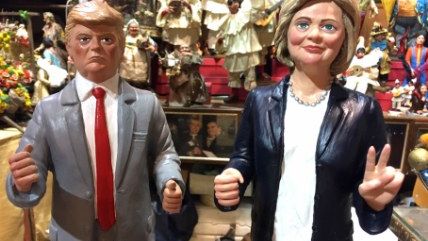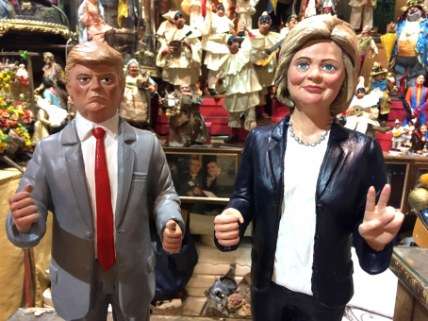Close to Two Million Actual Voters Ignored the Presidential Race
Even when they voted, more people bypassed the main event than usual.


We already know that one of the predictable consequences of having two unpopular major party candidates—Donald Trump and Hillary Clinton—led to poor voter turnout (when presented as a percentage of the voting population).
One of the post-election "Why Clinton lost" narratives was that the campaign didn't have as good a ground game in pivotal states as they needed. Somehow her unpopularity as a candidate didn't properly register with some party insiders and they didn't get out the vote the way they needed to.
Philip Bump over at the Washington Post has another interesting piece of data that could maybe help us understand the consequences of running these two against each other. They tallied together vote totals in 33 states and Washington, D.C., and determined that more than 1.7 million people in those states cast ballots where they did not select any presidential candidate at all. Not only did they ignore Trump and Clinton, they also waved away Libertarian candidate Gary Johnson and the Green Party's Jill Stein. This works out to two percent of the total number of votes. More people cast their vote for no president at all than voted for Stein. And given that there's some states left out of the analysis, the real number is actually higher.
Bump also compared these numbers to 2012 and discovered that the percentage of voters who declined to select a candidate for president dramatically increased in many states between the two elections. States like Montana, Arizona, and even Democratic stronghold California saw a significant number of voters decline to vote for president compared to 2012.
Be wary of comparing too closely though and drawing too strong a conclusion. First of all, we're talking about the difference in a re-election in 2012 versus two new candidates in 2016. It is entirely possible that a number of these voters sat out the 2012 race entirely. Flat turnout for the 2012 election was lower than for the 2016 race. Furthermore, in some states, California in particular, voters had many important ballot initiatives to consider. Sometimes there's a good reason for some voters to go to the polls even if they are not impressed or just don't care about the presidential candidate.
But there's still an important lesson for campaign operatives, if they can stop looking for other people (and countries) to blame for Clinton's loss. Bump notes: "In several states, the number of people who didn't vote was near or greater than the eventual margin of victory."
Several of those states were swing states. One of those states was Michigan, where more than 75,000 voters did not cast a choice for president. That would have been more than enough to have handed Clinton the state if only one-seventh of them had cast a ballot for her, Bump notes.
I'm not remotely interested in trying to teach the Democratic establishment how to run better campaigns and win elections. Rather, I'm much more interested in how these numbers represent the disconnection between voters and the people demanding their support.
I previously noted how 1.2 million California voters, given only the choice of two Democrats and nobody else, cast ballots but didn't vote in the race to replace Barbara Boxer in the U.S. Senate. Those were the early vote returns. I went back and checked out the final numbers and it's even higher: 2.2 million Californians voted for president but not a senator.
It's perhaps worth suggesting that when voters feel disconnected from politicians with self-serving backgrounds like Clinton and a from a system that is deliberately designed to limit choice yet still call it a "popular vote," it helps contribute to the environment for the kind of populist uprisings we've seen with Trump and Bernie Sanders. And the result may be the implementation of some really bad public policies, so it's worth figuring out how counter this trend rather than to blame it on Vladimir Putin.
Check out the Post's chart and info here.
